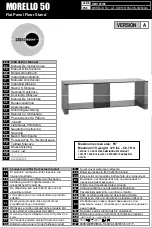
Installation Plan and Unpacking
3-8
Eaton
®
Power Xpert 9395 Integrated Battery Cabinet (Model 1085 and 1085HR) Installation Manual
164201687—Rev 06
www.eaton.com/powerquality
3.2.3
Interface Wiring Preparation
Read and understand the following notes while planning and performing the Interface wiring installation:
l
Control wiring for Battery Aux contacts should be connected at the customer interface connectors or
terminal located inside the battery cabinet. Use Class 1 wiring methods (as defined by the NEC) for interface
wiring up to 30V. The wire should be a minimum of 18 AWG rated at 24V, 1A minimum.
l
The Shunt Trip requires 48 Vdc to activate. Use Class 2 wiring methods (as defined by the NEC) for interface
wiring from 30 to 600V. The wiring should be a minimum of 18 AWG rated at 48V, 1A minimum.
l
The 9395C uses a UVR in the breaker that requires 48 Vdc to operate. Use Class 2 wiring methods (as
defined by the NEC) for interface wiring from 30 to 600V. The wiring should be a minimum of 18 AWG rated
at 48V, 1A minimum.
l
All interface wiring between the UPS and battery cabinet is to be provided by the customer.
l
When installing external interface wiring (for example, battery breaker shunt trip) to the battery cabinet
interface terminals, conduit must be installed between the battery cabinets and the UPS cabinet. Install the
interface wiring in separate conduit from the power wiring.
l
The Battery Aux and 48 Vdc Shunt Trip (or UVR) signal wiring from the UPS must be connected to the DC
source disconnect device.
l
Torque screw terminals to 20 lb in.
l
Auxiliary Contact Ratings:
240 Vac @ 15A
125 Vdc @ 0.3A
250 Vdc @ 0.15A
l
See Chapter 4, “Battery Cabinet Installation.” for the location of the customer interface terminals inside the
battery cabinet.
l
Refer to the appropriate Power Xpert 9395 UPS Installation and Operation Manual, as referenced in
paragraph 1.7 for UPS cabinet conduit and terminal specifications and locations.
NOTE
The 9395 system can trip a maximum of six battery cabinets total. This applies to
both the 1085 standard and High Rate series batteries. If more than six battery
cabinets in total are needed in a separate UPM battery configuration, DO NOT hook
up the shunt trips. Instead, use external hardware to perform the shunt trip
function.
















































